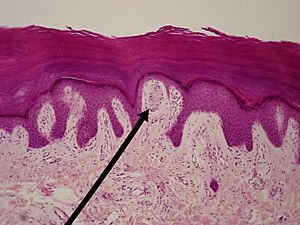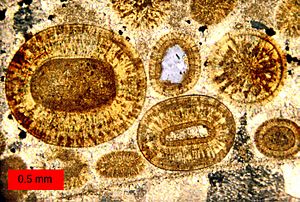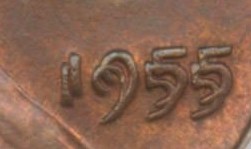Micrograph facts for kids
A micrograph is a special kind of photograph or digital image. It is taken using a microscope to make very small things look much bigger. Think of it as a super close-up picture of something you can't see well with just your eyes.
Micrographs show amazing details of tiny structures. They can help scientists learn how materials behave, what different parts are made of, or why something might have broken. Micrographs are used in many areas of science, from studying living cells to looking at metals.
Contents
Types of Micrographs
Light Micrographs
A light micrograph is made using an optical microscope. This process is called photomicroscopy. It's like attaching a camera to a microscope to take pictures of tiny objects. You can get very clear, magnified images this way.
Scientists started using photomicroscopy in England around 1850. Professor Richard Hill Norris used it to study blood cells. Later, Roman Vishniac became famous for taking pictures of living creatures moving around. He also helped create ways to take color micrographs.
You can even take light micrographs using a USB microscope. These microscopes connect right to your computer or laptop.
Electron Micrographs
An electron micrograph is a picture taken with an electron microscope. These microscopes use beams of electrons instead of light. They can show even tinier details than light microscopes.
Understanding Magnification and Size
Micrographs often include information about how much the image is magnified. They might also have a special line called a scale bar or micron bar.
Magnification tells you how much bigger an object looks in the picture compared to its real size. But this can be tricky! If you print the picture bigger or smaller, the magnification changes.
A scale bar is much more helpful. It's a line on the picture that shows a known length, like 1 millimeter or 10 micrometers. Even if you change the size of the picture, the scale bar also changes. This means you can always use it to measure things in the image. It's like having a tiny ruler right on the picture!
Micrography as Art
Microscopes are mostly used for science, but they can also create amazing art! Since they were invented in the 1600s, microscopes have inspired artists. Early microscope users like Robert Hooke were also great illustrators.
After photography was invented in the 1820s, people started combining microscopes with cameras. This allowed them to capture images directly instead of drawing them.
Since the 1970s, many people have used microscopes just to create beautiful art. Websites and traveling art shows, like the Nikon Small World and Olympus Bioscapes, display stunning microscopic images. These pictures are made just for people to enjoy their beauty.
Gallery
-
Measurements of a large amoeba at 400x.
-
Snowflake micrograph by Wilson Bentley, 1890
-
An image taken from a scanning electron microscope
Images for kids
See also
 In Spanish: Micrografía para niños
In Spanish: Micrografía para niños










